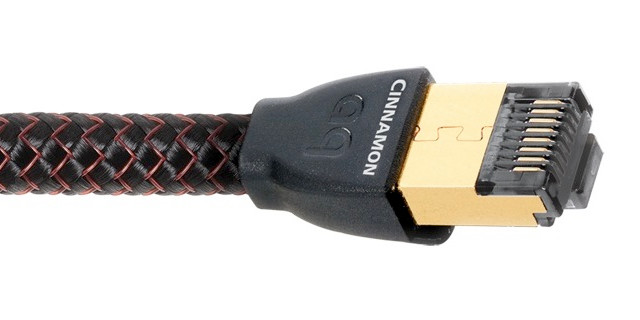Not every flight of audiophile fancy can be as awesome as buying your own mains power transformer to make your Queen LPs sound better. But René van Es’ “Audioquest Pearl and Cinnamon Ethernet cables” (The Ear, 2 September 2013) is a minor poetic classic in its own way.
Now that streaming audio has usurped my CDs the time has come to “listen” to Ethernet cables.
He’s streaming CD rips to 16/44 FLAC from a NAS to a media player. You might think this was digital data, streamed to the media player as it needs it, at a rate one fourteen-hundredth the speed of the cable, with a buffer that’s maintained inside the media player. But you’ll be amazed at the effect of changing the cable:
The sound with the Pearl becomes lighter and has less impact and detail compared to the Supra. Stereo image shrinks, but more obvious is a reduction in detail. Changing to Cinnamon with only one switch in my network produces a surprising result. One Million Bicycles from Katie Melua’s CD Live At The O2 Arena opens up and suddenly the public plays a much more important role at the beginning and end of the song. The people were always there but with the Cinnamon they not only come alive, they are also more spaced out and more like individuals.
Like the organ that comes to the foreground, the whistle is now tonally richer and Katie’s voice is more exciting. Small recording errors that appear, for instance when Katie gets too close to the mic, add to the live experience.
Let none mistake this for imagination, delusion or just making shit up.
You’ll be pleased to know he’s up to speed on technology:
This file is a 16/44.1 FLAC file ripped from a CD, it should be very easy to transport on a Gigabit network. One step higher is a studio master from Cæcily Norby at 24/96. Which means that over three times more data has to be transported.
That “over three times” is 24 × 96,000 = 2,304,000 bits per second, or a bit less than one four-hundredth the speed of his network.
I swapped Supra, Pearl and Cinnamon again using an old favorite, The Eagles’ Hotel California (24/192).
Because 24/192 certainly isn’t a jawdropping waste of bandwidth on an analogue tape recording from 1977. And his network cable only has room for another 199 simultaneous streams this size!
It is still surprising that Ethernet cables make a difference to sound quality. I didn’t believe it until I tried for myself.
In fact, I still don’t believe it.
You’ll be delighted to know the Audioquest Cinnamon is a relative snip at £79.00, and not the four to seven quid a perfectly good cable meeting the CAT-7 spec costs absolutely anywhere else. (Or about 20p if you crimp it yourself.)
I have been called a fool many times.
I wish I could write about actual music as soaringly as this guy writes about wires.


I wish I could sell them the cables… I don’t think I could keep a straight face, despite the margin.
1) Note in the specifications here: “Gold-Plated Connectors Provide 100% Shield”. I beg to differ. If this claim were true, a Nobel Prize in Physics would be forthcoming, as would a huge flood of orders from the entire electronics industry. Why sell cables to audiophiles for £70 each when you could rule data communications forever?
2) “Conductors Controlled for Digital Audio Directionality”. This is just so absurdly stupid as to be childish. How on earth do these people think that networking happens? Do they think that the NAS just “blows” digital audio at the output device like an old copper phono output? A directional Ethernet cable would be a serious problem, not a selling point.
3) He mentions using a Linksys switch in this setup. What does he think the Ethernet ports on his Linksys are made of – magical unicorn fairy dust? I think he’ll find they’re plain old PCB-mount shielded Ethernet connectors that aren’t made of anything like the materials of his cable.
It’s no Audioquest Diamond.
Fuck this with everything you can fuck things with.
Oh, no, I meant this: https://www.amazon.com/263-Audioquest-Diamond-Ethernet-Cable/dp/B0073HJVSK
“In order to fabricate copper or silver into a strand or conductor, it is first cast and then drawn (squeezed through a die). Even finest high-purity metals have imperfections and grain structure, which due to the direction of casting and drawing become non-symmetrical structures without the conductor. In ways which are not fully understood, both analog and digital audio performance is significantly affected by these non-linearities. While AudioQuest doesn’t pretend to fully understawnd this obvious distortion mechanicm, the solution is understood 100%. Use the conductors in the direction which reduces distoration!”
Fuck this with the Trump Tower.
Here’s JREF hitting this one: http://arstechnica.co.uk/gadgets/2015/08/even-vegas-strangers-agree-340-audiophile-cables-make-no-difference/